In future an ASX edition of the Trading Diary (sans US charts)
will be available on the website and emailed before 7:00 a.m. (Sydney time).
A later US market update will be emailed around midday.
Trading Diary
November 25, 2003
The intermediate trend is down. Expect support at 9500 and 9230.
The primary trend is up. A fall below support at 9000 will signal reversal.
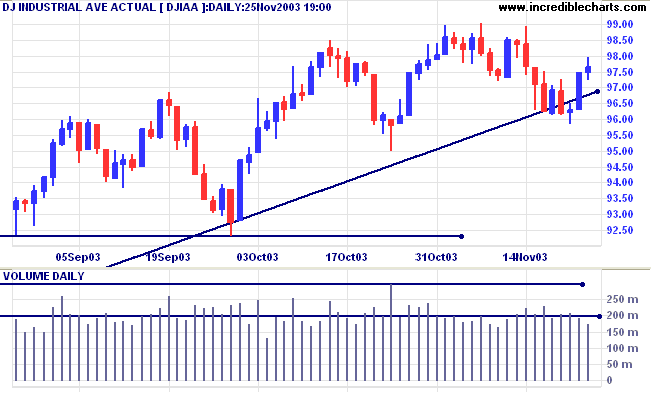
The intermediate trend is down. Expect support at 1840 and 1780.
The primary trend is up. A fall below support at 1640 will signal reversal.
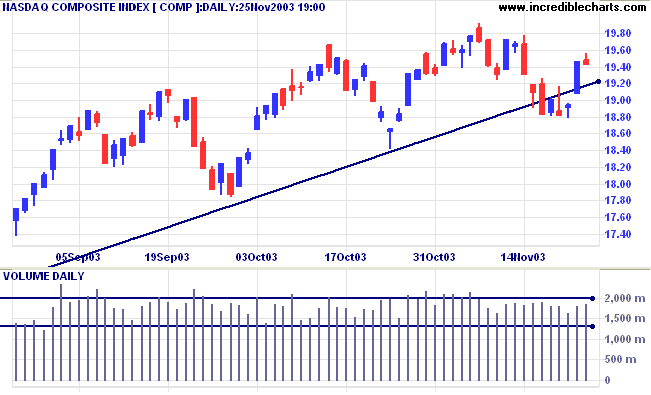
The intermediate trend is down.
Short-term: Bullish if the S&P500 is above the high of 1064. Bearish below 1049 (Today's low).
Intermediate: Bullish above 1064.
Long-term: Bullish above 960.
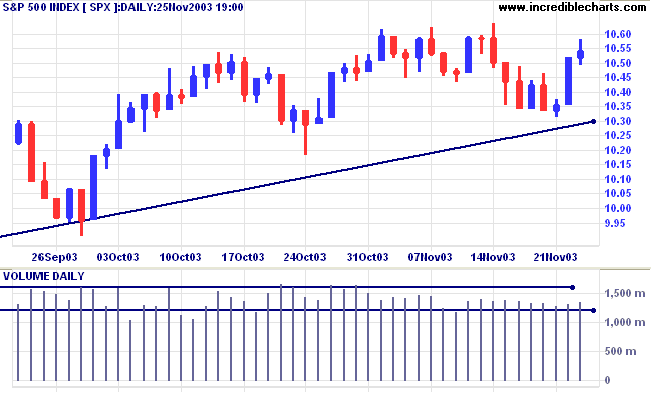
GDP grew at an annual rate of 8.2% in the third quarter - likely to already be discounted in current stock prices. (more)
The yield on 10-year treasury notes closed at the 4.19% support level.
The intermediate trend is down.
The primary trend is up.
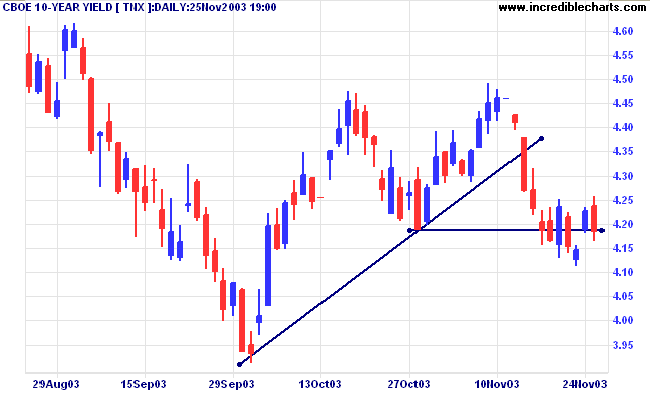
New York (20.13): Spot gold is level at $391.50.
The intermediate trend is up. Consolidation between 390 and resistance at 400 is bearish.
The primary trend is up. Expect resistance at 400 to 415.
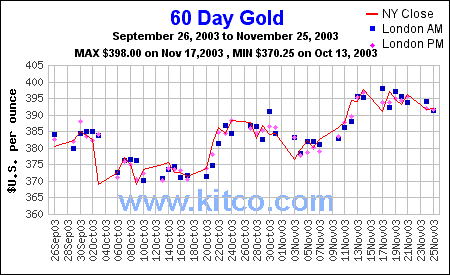
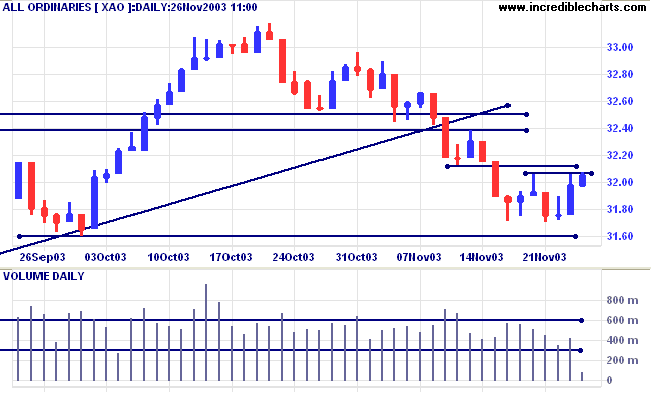
MACD (26,12,9) is below its signal line; Slow Stochastic (20,3,3) is below.
Short-term: Bullish if the All Ords rises above 3212. Bearish below Friday's low of 3171.
Twiggs Money Flow (100) signals distribution after a bearish triple divergence.
Intermediate term: Bullish above 3250. Bearish below 3160.
Long-term: Bearish below 3160.
Last covered on August 25, 2003.
BHP formed a new high at [1] while Twiggs Money Flow (100) fell sharply; a strong bearish divergence.
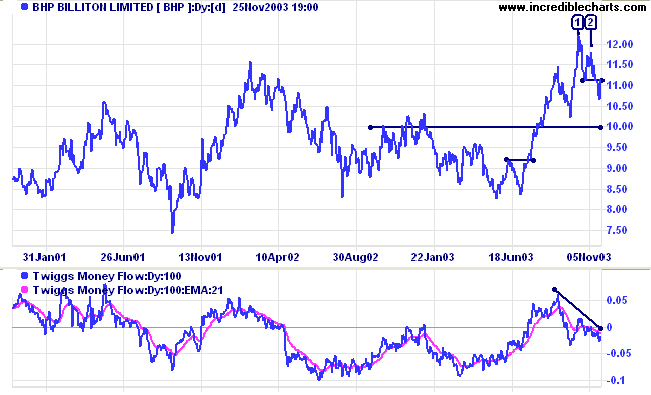
Prudent traders would only short the stock if price and RS respect the new resistance level, at the low between [1] and [2].
Earlier, a long entry was taken when price and RS respect the new support level at [e].
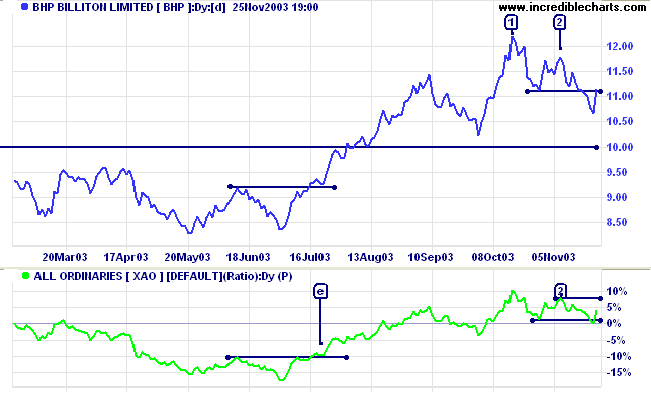
Last covered on August 25, 2003.
JBM has reversed sharply after a strong up-trend. Is this a secondary reaction or a stage 3 top?
Twiggs Money Flow (100) gives a clue, remaining below zero to signal distribution.
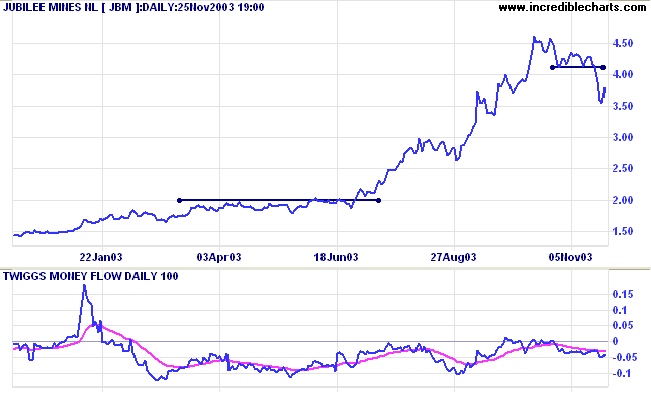
Earlier, a long entry at [e] was taken when the pull-back of price (and RS) respected a new support level.
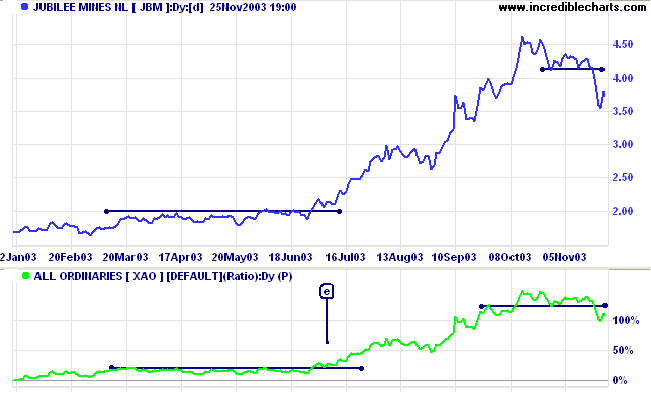
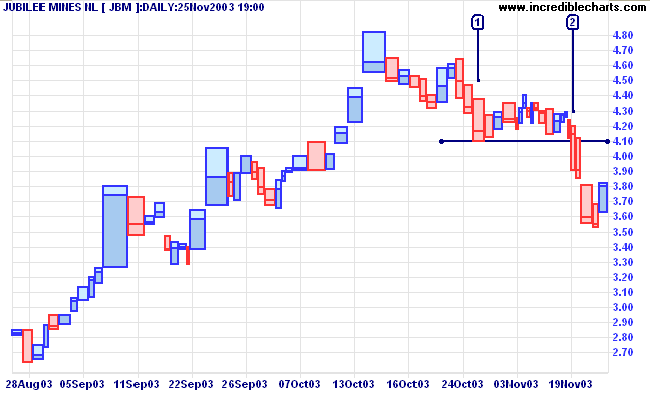
|
The paradox of our time in history is
that.... We have taller buildings but shorter tempers, wider freeways, but narrower viewpoints. We spend more, but have less. We buy more, but enjoy less. We have bigger houses and smaller families, more conveniences, but less time. We have more degrees but less sense, more knowledge, but less judgment, more experts, yet more problems, more medicine, but less wellness. We drink too much, smoke too much, spend too recklessly, laugh too little, drive too fast, get too angry, stay up too late, get up too tired, read too little, watch TV too much, and pray too seldom. We have multiplied our possessions, but reduced our values. We talk too much, love too seldom, and hate too often We've learned how to make a living, but not a life. We've added years to life not life to years. We've been all the way to the moon and back, but have trouble crossing the street to meet a new neighbor. We conquered outer space but not inner space. We've done larger things, but not better things. We've cleaned up the air, but polluted the soul. We've conquered the atom, but not our prejudice. We write more, but learn less. We plan more, but accomplish less. We've learned to rush, but not to wait. We build more computers to hold more information, to produce more copies than ever, but we communicate less and less. These are the times of fast foods and slow digestion, big men and small character, steep profits and shallow relationships. These are the days of two incomes but more divorce, fancier houses, but broken homes. These are days of quick trips, disposable diapers, throwaway morality, one night stands, overweight bodies, and pills that do everything from cheer, to quiet, to kill. It is a time when there is much in the showroom window and nothing in the stockroom...... |
~ Unknown.
Our server switch-over has taken longer than expected
but we are now in the final stages of the setup.
You can now view back issues at the Daily Trading Diary Archives.
Back Issues

Author: Colin Twiggs is a former investment banker with almost 40 years of experience in financial markets. He co-founded Incredible Charts and writes the popular Trading Diary and Patient Investor newsletters.
Using a top-down approach, Colin identifies key macro trends in the global economy before evaluating selected opportunities using a combination of fundamental and technical analysis.
Focusing on interest rates and financial market liquidity as primary drivers of the economic cycle, he warned of the 2008/2009 and 2020 bear markets well ahead of actual events.
He founded PVT Capital (AFSL No. 546090) in May 2023, which offers investment strategy and advice to wholesale clients.
